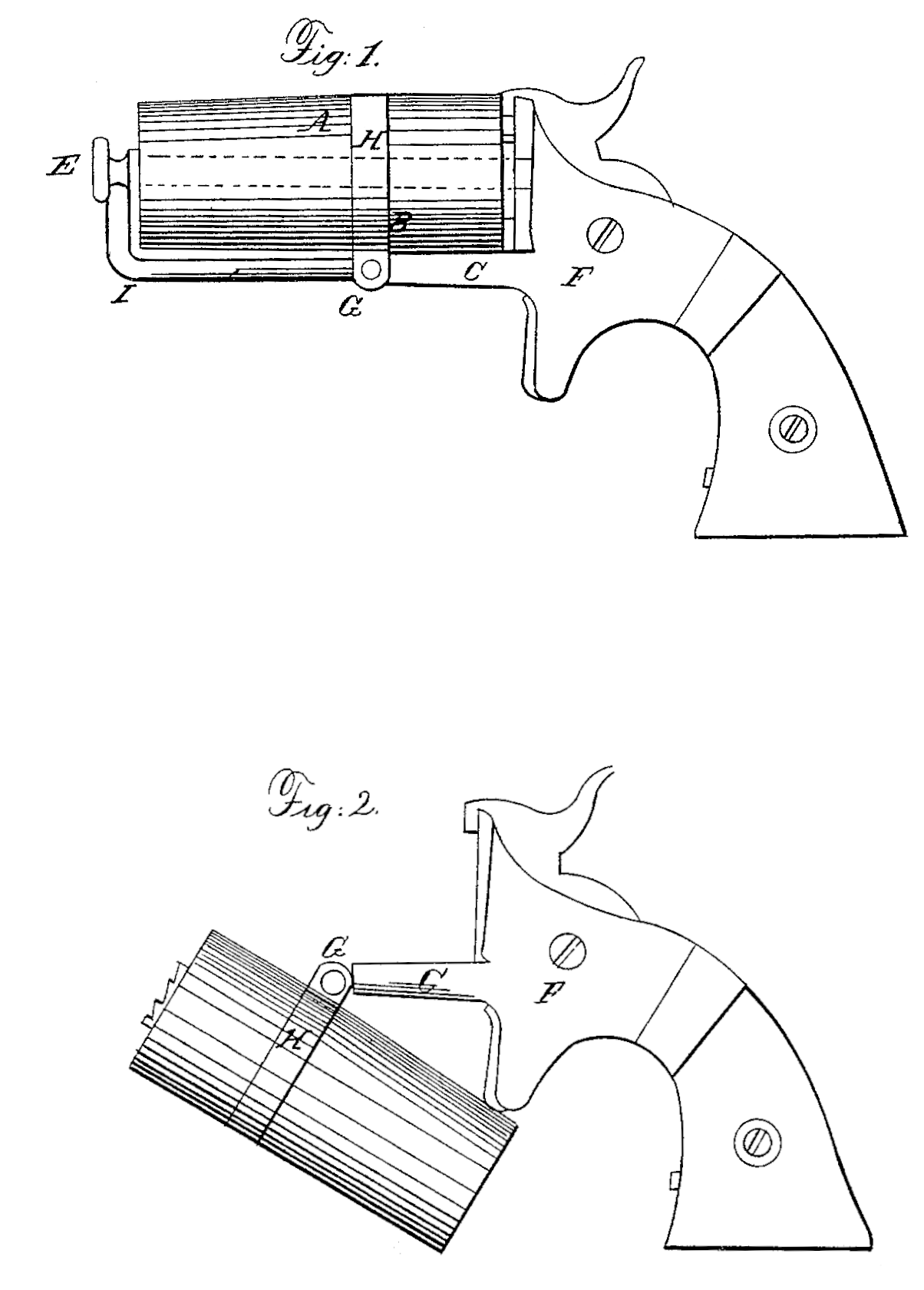US 57448
UNITED STATES PATENT OFFICE.
JOHN H. VICKERS, OF NORWICH, CONNECTICUT, ASSIGNOR TO THE BACON ARMS COMPANY, OF THE SAME PLACE.
IMPROVEMENT IN REVOLVING FIRE-ARMS.
Specification forming part of Letters Patent No. 57,448, dated August 21, 1866.
To all whom it may concern:
Be it known that I, John H. Vickers, of Norwich, in the county of New London and State of Connecticut, have invented a new and useful Improvement in Fire-Arms; and I do hereby declare that the following is a full, clear, and exact description thereof, which will enable others skilled in the art to make and use the same, reference being had to the accompanying drawings, forming part of this specification.
Figure 1 is a side view of a revolver made according to my invention. Fig. 2 is a side view of the revolver, showing the barrel turned down on the hinge.
The object of this invention is to simplify and improve the class of fire-arms known as “revolvers.” The barrel is connected to the stock by a pin, on which it revolves, and which goes through the whole length of the barrel, being screwed into the stock. A support is provided beneath the breech or hinder part of the barrel by means of a bracket that is extended from the stock, close to it, but not in actual contact, so that the barrel will be prevented from tipping, and the pin on which it turns be preserved from being bent down by the strain produced by discharging the arm. When the pin is unscrewed from the stock the barrel is free to be turned down from before the stock, but is still attached to it by a joint that connects a band or collar that surrounds the barrel with the bracket. The band or collar is confined in a groove cut around the barrel; but the latter is free to turn within it.
The letter A designates the revolving barrel of a fire-arm having several chambers, that are brought in succession into line with the hammer by the act of cocking the hammer. The barrel turns on an axial pin, E, which is passed through the barrel from the front and is screwed into the forward end of the stock F, the direction of the screw-thread thereon being the same as the direction of rotation of the barrel, so that the pin will not become unscrewed by such rotation.
C is a bracket, which extends from the forward part of the stock beneath the barrel and close to it, but not so as to come in contact with it during its rotation.
The bracket prevents the barrel from being tilted forward when a cartridge is exploded in any of its chambers, and consequently it preserves the pin from being bent by that cause. The barrel is reduced a little in diameter on a line, B, forward of the breech or that part which holds the cartridges, so as to form a circumferential groove, which receives a band or collar, H, that fits loosely to allow the barrel to rotate therein, while it is not allowed to move longitudinally through it.
The band is connected to the bracket by a joint, G, of any suitable construction, so that when the pin E is unscrewed from the stock the barrel may be turned away from the stock without being detached from it. The joint may be made so that the barrel can be turned down or horizontally.
The outer end of pin E has in this example a right-angled arm, I, which, when the pin is screwed up, comes beneath the barrel, its free end terminating opposite the end of the bracket at the place of the hinge. This arm I, when so applied, serves as a convenient finger-piece whereby to turn the pin, both for screwing and unscrewing it, the arm revolving about the barrel; but it can be dispensed with, and I do not in this application chain it in connection with the pin.
The bracket C holds the usual stop or detent, which keeps the barrel from revolving by becoming engaged with one of a series of depressions made on the outside thereof.
It will be observed that the bracket and the band serve to support the pin E against the force of the explosion, which tends both to separate the barrel from the stock and to bend the pin by tilting the barrel.
What I claim as new, and desire to secure by Letters Patent, is—
The pivoted bracket C, arranged and operating in combination with the band H, encircling the barrel loosely, and with the axial pin E, in the manner and for the purpose herein specified.
The above specification of my invention signed by me this 22d day of January, 1866.
JOHN H. VICKERS.
Witnesses:
WM. H. BLISS,
JAMESS. CAREW.

